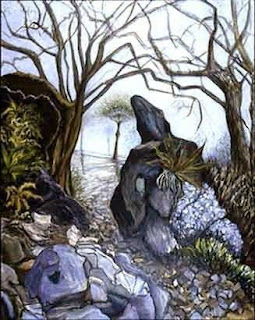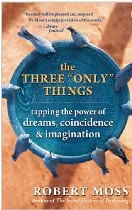I arrived at my local airport at 5:30 am on a Sunday, checked my bag, and got in line for the security check. Before I produced my drivers license and boarding pass, the female TSA agent who was doing the documents scan greeted me by name, like an old friend, "Well, hello, Robert!"
Her Southern accent was familiar and so was her warm smiling face. I recognized a woman who had been a member of one of my monthly evening circles more than a decade before. She had entertained us with wonderful stories of growing up in the rural South and of dream travels to ghost villages and other locations that are not on airline itineraries. "How come you're working here?" I asked her. "I was dreaming about airports so much I decided I might as well work at one."
Her Southern accent was familiar and so was her warm smiling face. I recognized a woman who had been a member of one of my monthly evening circles more than a decade before. She had entertained us with wonderful stories of growing up in the rural South and of dream travels to ghost villages and other locations that are not on airline itineraries. "How come you're working here?" I asked her. "I was dreaming about airports so much I decided I might as well work at one."
It felt like a very good start to the day, to meet a gatekeeper who is also a dreamer. The Gatekeeper is a very important figure in my imaginal life. In dreams, the Gatekeeper may appear as a generic figure familiar on the roads of regular life - the customs officer, the ticket collector, the security guard. Sometimes the Gatekeeper appears in more enigmatic or mythic guise. I have met the Gatekeeper, in my dreams, as a slick fellow beckoning me towards an open archway, leading to delightful vistas of life possibilities, while holding a door I was trying to force open shut. I have met the Gatekeeper in dreams - and on the dashboard of an Indian taxi driver, after riding on Air India - as elephant-headed Ganesha, and as a black dog who sometimes walks on two legs, as Anubis does.
I am very much alive the play of the Gatekeeper (who can be a trickster, especially if we are too set in our ways) in the ordinary reality of airports, on the way to different planes. At Sea-Tac airport, some years ago, a cute dark-skinned TSA agent laughed in my face when she inspected my drivers license. "Why are you laughing?" I asked her. "It's because of your name. In my language, 'Moss' means 'Banana'." "What language would that be?" "Somali". The humorous side of the Gatekeeper was definitely in play that day. Just think about it. Being teased at an American airport because your name means something funny in Somali.
At Boise airport, an older, balding TSA guy asked me if my rather abundant white hair was my own. "Absolutely." "Sonufabitch. I really want that hair." "Sorry, it's not available."
After I sent my carry-ons through the X-ray machine at my home airport in upstate New York, I was stopped by the security guards. "You got a lampshade in here?" The guard indicated my drum-bag. "Actually, it's a drum." I willingly extracted the simple frame drum that has powered many, many group journeys in my workshops so they could see. "Will you play it for us?" the guard requested. "Excuse me?" "Go on, we'd like you to play." So there, just inside the security barrier, I was tapping out the heartbeat of the drum, surrounded by smiling faces. That felt like another good start to the day.
I've saved the best story of brushes with the airport Gatekeeper for last. This was back before 9/11.I had been leading a shamanic gathering up on a very special mountain and had rushed to the airport without considering what tools and toys I had stuffed in my drum-bag. On the other side of the X-ray machine, a security guard asked me, "Is this yours?" To my horror, I saw he was holding up a ceremonial Lakota knife with an elk-bone handle that he had just removed from my drum-bag. He extracted the blade from the sheath and held it up. "Wait here. I have to get my supervisor."
Wild thoughts are thrashing in my brain. They'll arrest me. They'll grill me. At least they'll give me a tongue-lashing for being such a fool as to leave that knife in a carry-on bag.
The supervisor appears. His first words are, "What time is your flight?"Six-fifteen."
"Good. We've got time to get this in your checked luggage so it can meet you at the other end. I'll walk you back to the ticket desk." With this, he hands me the knife, still out of its sheath.
I wonder if I am dreaming as I accompany him, knife in hand, back through security.
"Go on, do it," he says.
"Do what?"
"You're Australian, aren't you? Do the Crocodile Dundee thing."
So I put on my best strine accent and snarl, brandishing the knife, "Call that a knife? This is a bloody knife, mate!"Gales of laughter. The ticket agent was delighted to put his long line of passengers on hold while he dashed to get my knife into my checked suitcase, saying "I know you Aussies can't go anywhere without a bloody knife." I guess the Gatekeeper was truly in laughing mood that day. And that he sometimes makes special rules for people from Down Under.
For more reflections on meeting the Gatekeeper and dancing with the Trickster, please see my book Sidewalk Oracles: Playing with Signs, Symbols and Synchronicity in Everyday Life.

















